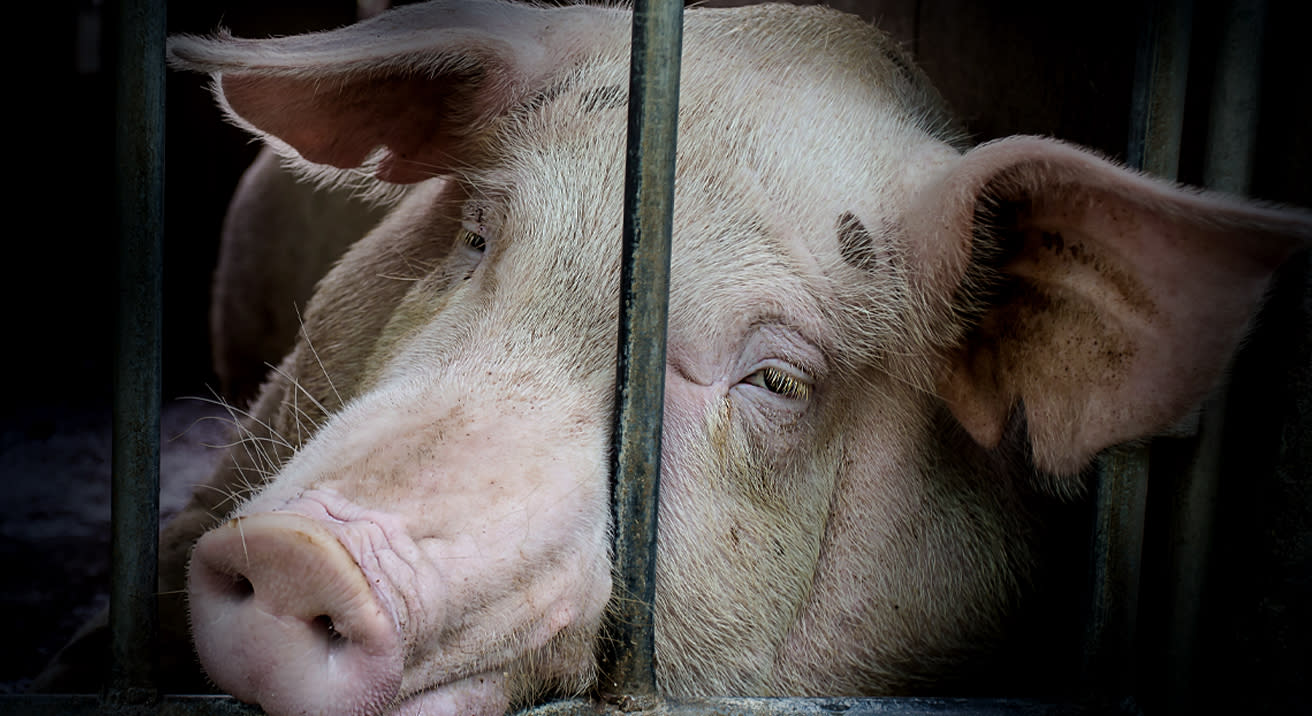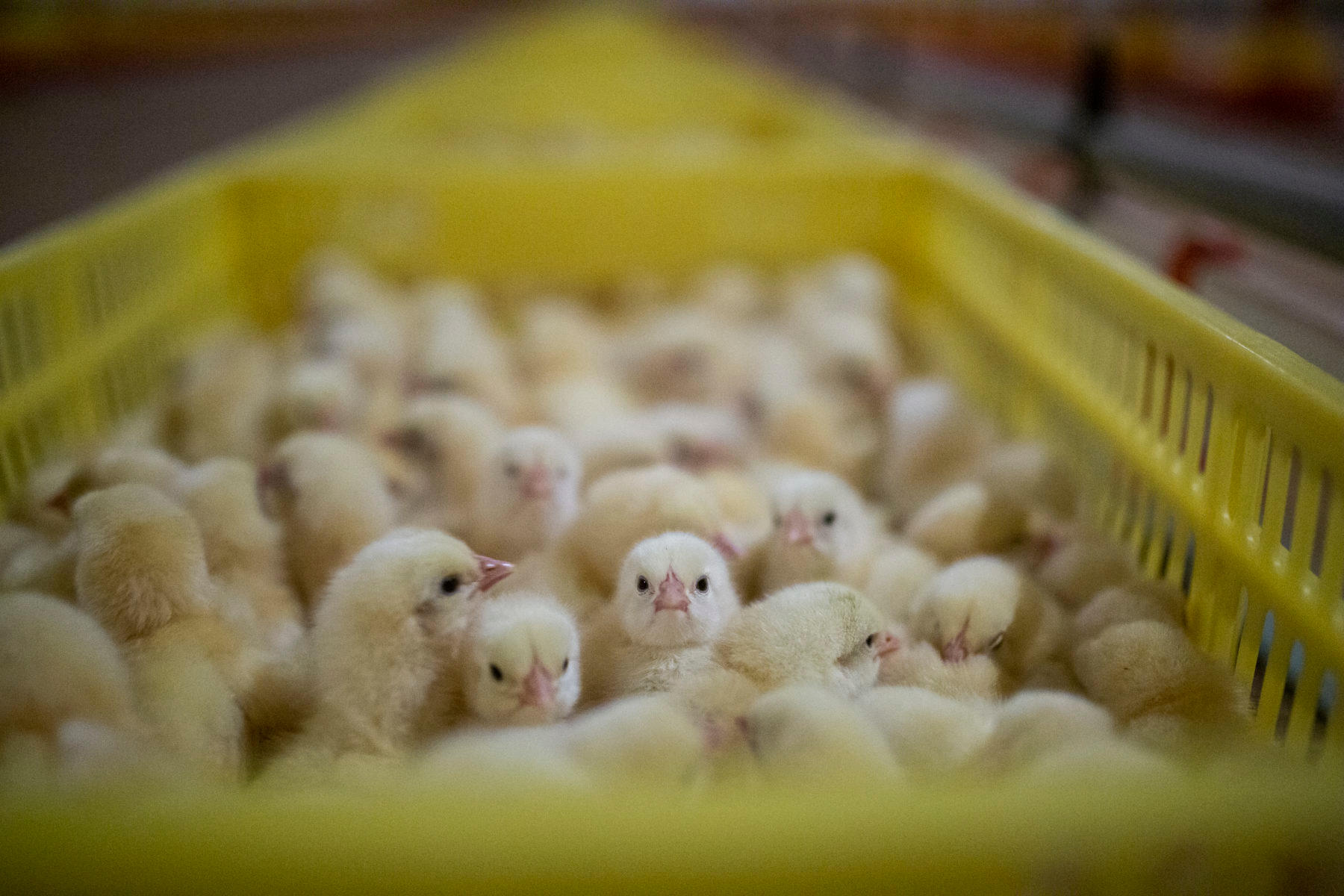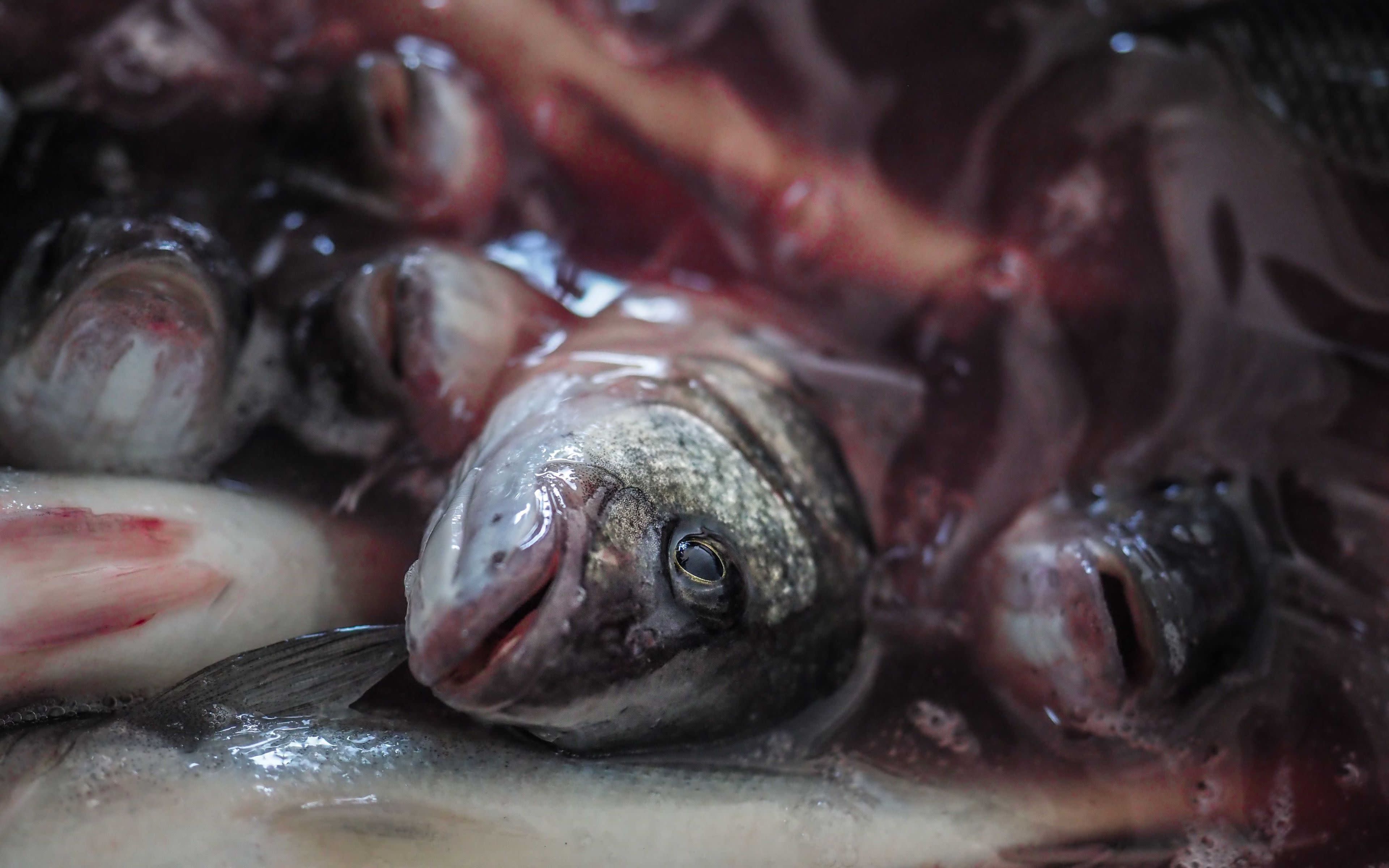




For decades, veterinarians and animal behaviorists considered the Five Freedoms model the “gold standard” of animal welfare. However, these protections don’t go far enough to ensure animals can live happy, healthy lives.

All living beings have basic necessities: food to eat, water to drink, and shelter to keep us safe. Once we can secure those essentials, we can focus on the things that make life worth living—things like companionship, love, belonging, respect, freedom, and creativity. In order to help humans provide animals with the essentials they need to live, animal behaviorists developed the Five Freedoms of Animal Welfare. While well-intentioned, these “freedoms” are open to interpretation, and in many ways, they don’t go far enough to protect animals from the cruelty of factory farms.
What are the Five Freedoms of Animal Welfare?
Animal welfare refers to the living conditions of animals who humans keep in captivity, including companion animals like dogs and cats in the home, exotic animal species in aquariums and zoos, and animals who are raised in the food system. Humans control these living conditions, and, if the conditions they provide are sub-par, animals might not be able to survive. This is why, in 1965, Irish zoologist Francis Brambell researched and recommended a basic set of standards for all animals under human control, regardless of species.
Brambell recommended that all animals should have five freedoms: the freedom to “stand up, lie down, turn around, groom themselves and stretch their limbs.” After adding more detail to Brambell’s original list, the United Kingdom’s Farm Animal Welfare Council codified the Five Freedoms of Animal Welfare in 1979, endorsing them as “the best possible standards of welfare for animals.” Since then, various groups have adopted these standards, including the ASPCA, American Humane, and the American Veterinary Medical Association.
These are the five freedoms:
Freedom from hunger or thirst
All animals should have “ready access to fresh water and diet to maintain health and vigor.”
Freedom from discomfort
All animals should have shelter and a comfortable place to rest.
Freedom from pain, injury, or disease
All animals should receive proper medical care, including preventative care and rapid diagnosis and treatment for injuries or disease.
Freedom to express normal behavior
All animals should have “sufficient space, proper facilities and company of the animal’s own kind.”
Freedom from fear and distress
All animals should receive conditions and treatment that allow them to “avoid mental suffering.”
What is the importance of freedom for animals?
For thousands of years, different animal species developed ways to survive in their natural habitats. Some species are even genetically “pre-programmed” to find food and shelter, mate with each other, and care for their offspring. However, when humans remove animals from their natural habitats and place them in captivity, animals can quickly lose their ability to act on their survival instincts. They’re cut off from open spaces where they can hunt and forage for food. They don’t have natural features like trees or rocks where they normally take shelter. They may not even be able to see other members of their own species.
When humans remove an animal from their natural habitat, it becomes the human’s responsibility to provide the animal with what they need to survive. This is where the Five Freedoms come in. Although there’s no way for animals to live their life to the fullest in captivity, the Five Freedoms establish guidelines for humans to create a living situation for animals that still allows them to express their instincts and behaviors—food to eat, water to drink, shelter to sleep in, space to move around in, and friends and family to interact with. In short, the Five Freedoms are important to preserving animals’ health in captivity, both physically and mentally.
What are the problems with the Five Freedoms?
The Five Freedoms assert every animal’s right to humane treatment from the humans who look after them, regardless of their species. Yet, every day, animals still suffer from unimaginable cruelty at the hands of humans—even in supposedly “humane” facilities.
This cruelty runs especially rampant in animal agriculture, as factory farms trap cows, pigs, chickens, turkeys, and goats in filthy, overcrowded facilities with no sunlight or access to the outdoors—a far cry from anything that remotely resembles their natural habitats. And, even though these farms can look to the Five Freedoms as “the gold standard” for animal welfare, their facilities don’t provide animals with anything close to the treatment they need to preserve their physical and mental well-being. Factory farms see animals as machines to generate profit, and sacrifice animal welfare in favor of what would be most effective for their bottom line.
This is where the Five Freedoms fall short. Its standards are open to interpretation—allowing factory farms to ignore measures to protect animal welfare—and they do not actually reflect everything that animals need to preserve their physical and mental well-being.
The Five Freedoms are too vague
There’s no way for animals to tell us how they’re feeling in plain language—we can only make our best guesses based on what behaviors we observe at any given moment. Essentially, this is all that the Five Freedoms are: humans’ best guesses on how to treat animals and minimize their suffering.
The Five Freedoms are vague and don’t provide concrete, measurable guidelines to follow. How much space is “sufficient”? How “fresh” is fresh food and water? How “rapid” is rapid treatment? There are no specifics on how to measure whether or not animals are getting the amount of food, space, and care that they need, leaving companies and individuals who keep animals in captivity to interpret the guidelines and implement them how they want to.
This means that, even when humans design their environments with the Five Freedoms in mind, animals can still suffer. For example, recognizing that fish need the freedom to swim around, a company designing a fish farm may construct large tanks that hold thousands of gallons of water for the fish to live in. However, the company might “stock” the tank with so many fish that the fish can only swim in a tiny circle without bumping into other fish—creating a highly stressful situation for animals.
Perhaps the only way to determine if an animal is experiencing the Five Freedoms is whether they express their “natural behaviors”—but, even then, “natural” behavior is difficult to pinpoint when an animal’s behavior is directly impacted by their environment, and their own lived experiences.
So, although an animal might receive the utmost level of care and humane treatment, the very act of confining animals causes them to repress their instincts, which can lead to high levels of anxiety and distress—something that scientists can actually quantify. On average, all mammals in captivity—from guinea pigs to African bush elephants—have higher levels of stress hormones in their blood than their wild counterparts. This chronic stress weakens their immune systems, making them much more susceptible to disease. This means that, even if animals are in conditions that appear to give them freedom to express “natural” behaviors, they still experience fear and distress—rendering the fifth freedom of animal welfare meaningless.
The Five Freedoms promote humane washing
“You vote with your dollar.” Over the years, this phrase has popped up to promote conscious consumption—if consumers don’t want to support companies that harm the environment or abuse animals, they can choose products that are labeled “eco-friendly” or “cruelty-free,” even if they have to spend a little more money to get them.
However, as companies have wisened up to consumer preferences, they’ve found ways to mislead consumers through marketing and deceptive labelling. In recent years, more companies have started “humane washing,” the unethical practice of marketing products with “misleading claims about the treatment of animals or the conditions in which they are born, raised, or killed.”
The Five Freedoms are vague and open to interpretation, which means that animals can still suffer greatly under animal welfare policies that use these guidelines. For example, a farm that raises chickens for meat may superficially adhere to the Five Freedoms: the chickens have access to food and water, shelter, preventative veterinary care, and adequate space to move around. However, upon closer inspection, these factory farm environments do little to actually ensure chickens are getting what they need to live.
Over 500,000 individual chickens can be packed into one chicken farm, making it nearly impossible for them to receive individual care and attention that they might need. Their “shelter” is a windowless, climate-controlled shed, where the floors are covered with feces and ammonia. Their “preventative veterinary care” comes in the form of mass amounts of antibiotics, which cause chickens to grow unnaturally large, unnaturally fast. Their rapid growth often causes a chickens’ legs to give out under their own weight, making them unable to walk or stand. Often, when chickens are too weak to survive on their own, farms will address their suffering not by giving them medical treatment, but by brutally snapping their necks to “put them out of their misery.”
Of course, this misery would be avoidable in the first place if chickens were not subjected to abuse and neglect their entire lives—from the physical anguish of being trapped in a body too big to support them and the mental anguish that comes from being in a state of constant pain and distress. However, in our profit-driven food system, a chickens’ life is only worth a few dollars. It’s easier and cheaper for factory farms to allow chickens to suffer from horrific conditions than to give them the individual care and attention that they need.
Overall, factory farms barely consider chickens’ health and well-being. Yet, technically, the factory farm provides chickens with access to food, water, veterinary care, and appropriate facilities called for by the Five Freedoms. Because the Five Freedoms guidelines are so vague, the company that subjects chickens to these horrific conditions can tell consumers that they honor the Five Freedoms of Animal Welfare.
Sadly, this is just one example of how bad faith actors can use the Five Freedoms to claim that they prioritize animal welfare, when they are really doing the bare minimum to protect the health and well-being of the animals in their custody. At worst, companies can use the Five Freedoms to mislead consumers who are understandably concerned about animal welfare to think they are buying a “humane” product, when animals are still suffering from abuse and neglect, every day.
Beyond the Five Freedoms: a life worth living
Imagine that you live in an apartment. You have running water, a pantry that’s regularly restocked with healthy food, and a comfortable bed. You even have a roommate or two to keep you company every day. But, the catch is: that’s it. That’s all you have, and you have no way to leave. This living situation has everything you need to survive, but can you actually thrive? This is what life is like for animals under the Five Freedoms. Their guidelines focus on minimizing the negative, but not promoting the positive.
Sure, it’s great that animals don’t have to worry about getting food, water, or other things they need to survive, but this “does not in and of itself generate positive experience.” Even under the most watchful care, animals in captivity still experience anxiety and depression. They’re lonely, bored, and lacking stimulation. Simply put, they’re just surviving—not thriving.
To address the shortcomings of the Five Freedoms, animal welfare experts and advocates propose moving away from these guidelines and towards providing animals with “a life worth living.” Not only should humans provide animals in captivity with the basic necessities they need to live, they should also do their best to give animals positive experiences during their lives.
These positive experiences can take many forms: pigs love foraging in the pasture for food, cows love grooming and showing each other affection, and chickens love to explore and perch on trees. When humans take time to learn what type of behaviors and activities enrich animals’ lives, they can craft specific, measurable animal welfare standards for each species.
For example, some animal welfare policies claim to give chickens access to the outdoors, but it may only be through a single, tiny door that chickens would have to wade through thousands of other birds to get to. The “outdoor space” may just be a small patch of concrete.
However, an animal welfare policy that’s crafted to truly give chickens a life worth living could ensure that chickens have ready access to big, grassy fields whenever they feel like going outside. When chickens have the enrichment that they need to thrive in captivity, they express their contentedness—they frolick, play-fight, and even engage in games of tug-of-war with other chickens.
Regardless of how these animal welfare standards take shape, giving animals a “life worth living” requires a degree of genuine consideration and care from humans—care which is completely absent from our broken factory farm system, which places profit over the well-being of animals raised for food.
While it’s important to update animal welfare standards to give animals a life worth living, the best way we can reduce their suffering right now is to leave animals off our plates. And, the good news is that there are more plant-based food options on the market than ever before, meaning that we can meet our own nutritional needs without raising or killing animals for food. Learn more about how you can “vote with your dollar” to make a kinder world for animals with a free plant-based starter guide.
 Amanda Waxman
Amanda Waxman




